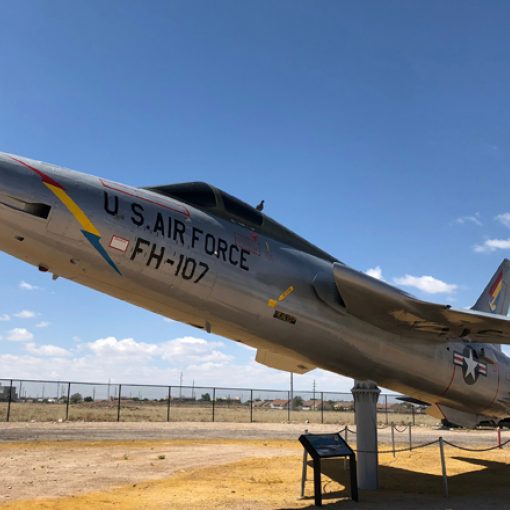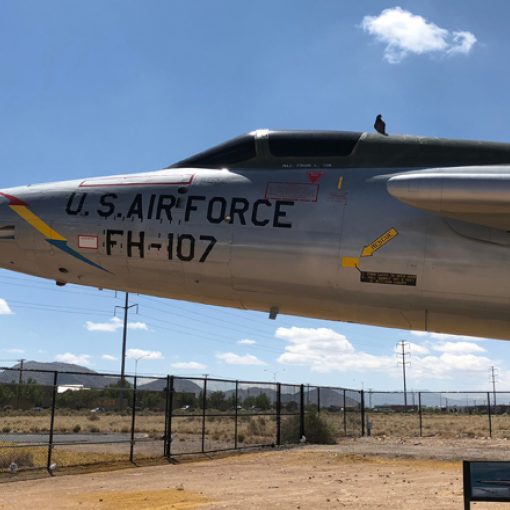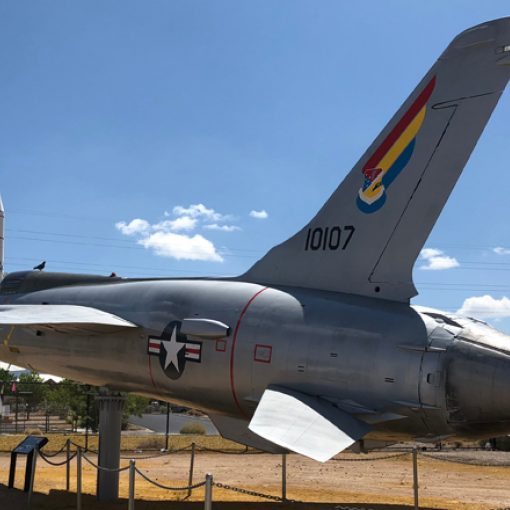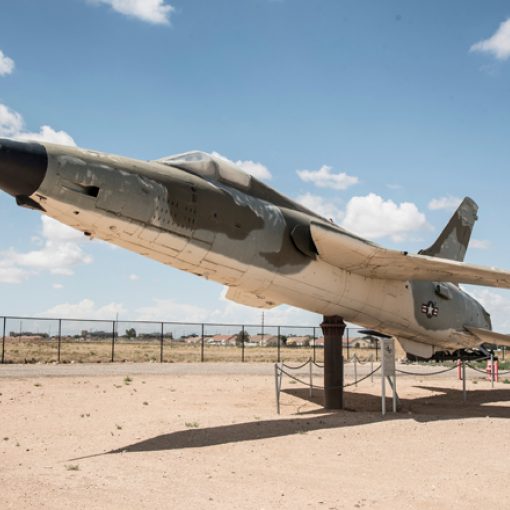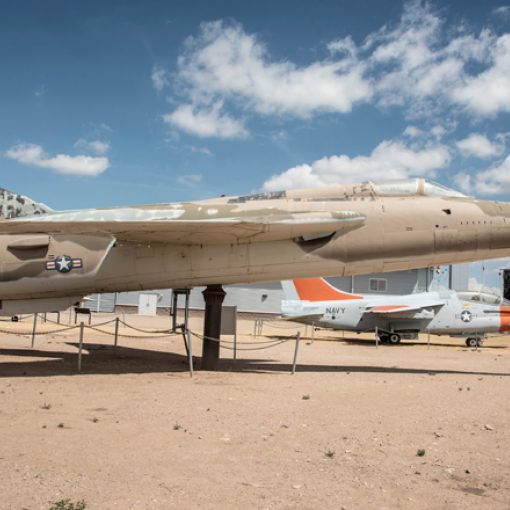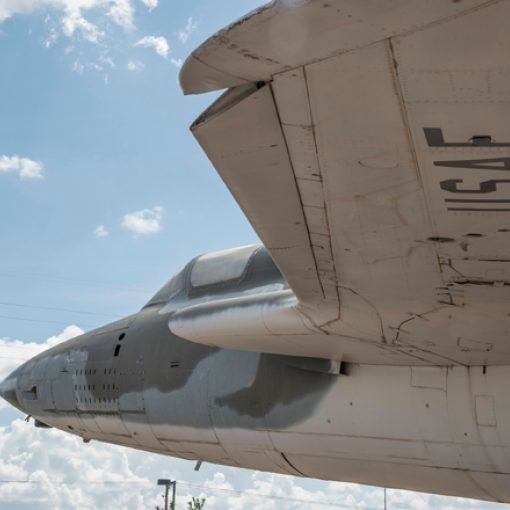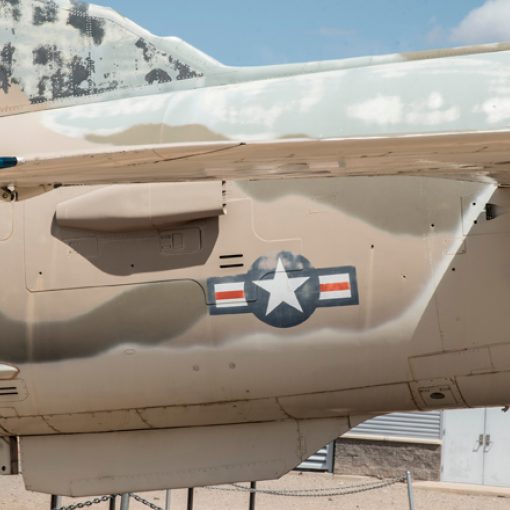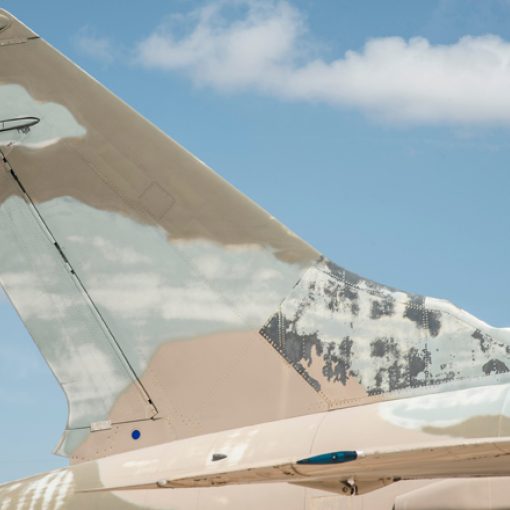Completed F-105D Thunderchief
Two of the National Museum of Nuclear Science & History’s iconic fighter-bombers, the F-105D Thunderchief and the A-7 Corsair II,
were the focus of the museum’s special initiative within “Operation
Preservation” – a multi-year campaign to repaint and refurbish the
airplanes in the museum’s nine-acre outdoor exhibit area known as
Heritage Park in the spring and summer of 2017.
Restoration began in the spring on the museum’s F-105D Thunderchief, serial number 61-0107, a supersonic fighter-bomber that was produced in 1962 by Republic Aviation, Farmingdale, NY, and was sent to the 49th Tactical Fighter Wing (TFW) in Germany to provide NATO nuclear retaliation capability during the depths of the Cold War.
(In the late 1960s, the Defense Budget began to be squeezed by the costs of the ongoing Vietnam War. Secretary of Defense Robert McNamara decided to reduce costs in Europe by "Dual Basing" United States military units in Europe by returning them permanently to the United States, and conducting annual deployment exercises in Europe, giving the units a NATO commitment for deployment to bases in Europe if tensions with the Soviet Union warranted an immediate military buildup.
The 49th Tactical Fighter Wing was returned to the United States under this policy, being reassigned on July 1, 1968, to Holloman AFB, New Mexico, to serve as the U.S. Air Force's first dual-based, NATO-committed wing. The 49th TFW is still stationed at Holloman AFB, New Mexico.)
After its use for pilot training in McConnell AFB, Kansas, and Nellis AFB, Nevada, it joined the Kansas Air National Guard at McConnell, AFB. It was later transferred to the Washington D.C. Air National Guard in 1979. It landed for the final time at Kirtland AFB, Albuquerque, NM, in 1981.
Kirtland
AFB was only supposed to be a location for the aircraft to refuel on
its way to the Aerospace Maintenance and Regeneration Center, or
“Boneyard,” in Tucson, AZ, but complications prevented it from leaving
Albuquerque. On its takeoff from Kirtland, it lost power and the pilot
dropped an emergency hook from the back of the plane to catch the
one-inch steel cable that stretched across the runway at the Albuquerque
International Airport. The pilot was not injured, and after the
aircraft was repaired, it was offered to the then National Atomic Museum
for permanent display. It has now been a part of the museum’s
collection for 35 years.
When the Thunderchief entered service, it was the largest single-seat, single-engine combat aircraft in history, and it could exceed the speed of sound at sea level and reach Mach 2 at high altitude. Built by Republic Aviation – with a length of 64 feet and 4.75 inches and a wingspan of 34 feet and 11.25 inches – the F-105 conducted the majority of strike bombing missions during the early years of the Vietnam War. During the war, the single-seat F-105D was the primary aircraft delivering the heavy bomb loads against the various military targets.
Restoration of both aircraft began in April of 2017 under the supervision of General Jay Bledsoe, Project Manager, with the help from museum staff and volunteers and will be funded by donations received from supporter and entities with personal ties to the museum and the historic aircraft. The F-105D was the first aircraft to be repainted, receiving trim and insignia to look as it did when it was active in the 49th TFW in Germany as part of NATO. After its completion, focus then moved toward the A-7, repainting the surface to revive the paint colors of orange and grey. The total restoration cost for both the F-105D Thunderchief and A-7 Corsair II was $45,000.
Completion of these outdoor exhibits for visitor viewing took place in the winter of 2018.
The museum has successfully restored three other aircraft in Heritage Park, including the F-16 Fighting Falcon, the B-29 Superfortress and the B-52 Stratofortress.
The National Museum of Nuclear Science & History launched an ambitious campaign through Indiegogo - a funding platform for creative projects, directly supported by individuals who pledge money - April 14 through May 14, 2017 - to purchase the paint for the restoration of the museum’s iconic F-105 and A-7.
Since one gallon of paint for these airplanes costs $460 and one gallon of primer costs $300, the Museum’s staff decided to incorporate Indiegogo in order to ‘kick start’ the fundraising aspect of the restoration projects. It was through the generosity of 86 backer that the museum was able to raise $9,605 to help pay for paint and primer.
Thank you to the following supporters:
$500 Supporters:
Milo Myers
William Scott Handy
$250 Supporters:
Ryan Brukardt, Jennifer Cline, Donald Hall, Robert Hammerstein, Thomas Rose
$100 Supporters:
Kristin Bush, Damon Giovanielli, Jeffrey Mahn, Jim Saunders, Nicholas Shanayda
$50 Supporters:
Robert and Suzanne Busch, Andrew Funk, Stephen Greeley, William Clay Jones, James R. Reddin, Perry Robertson, Steven Shook, Jeff Terry
$10 Supporters:
Paul Carbin, Jean and Roger Cox, Lorenzo Dutto, John Hodges, George Laskar, Thomas M. Lore, Kelly D. Michals, Calvin Shields, Nicholas M. Williams
